
Writing NFT Deep Articles weekly | Columnist @Foresight_News Member @theNextDAO | @AlibabaGroup & ex-Douban PM
4D Long Article: Building the Soul of a Web3 Brand 3 Questions-Why, What, How
foreword
Two very appropriate news in the past two days, Starbucks announced its plan to enter web3, to build a blockchain-based user loyalty platform; Top blue-chip NFT project doodles announced $5400w financing, to build a world-class entertainment brand native to web3 . On the one hand, top web2 brands are transforming to web3, and on the other hand, the growth of web3 native brands is accelerating. We are on the eve of the explosion of web3 brands .
During this time, I also read a lot of articles about the web3 brand, but more at the technical level. Communicate with friends of web2, the biggest confusion at present is actually at the level of Tao, why do you do this? What exactly does a web3 brand mean and how is it different from a web2 brand? After clarifying these questions, traditional brands have a more comprehensive understanding and preparation before they can take the step of why and explore what and how. Borrowing the model of "Soul 3 Questions" in my favorite podcast "Blooming in Arts and Science", through this article, I try to answer the 3 questions of the soul of building a web3 brand-Why, What, How, from Taoism to Technique
- Why: Why is web3 a must for brands?
- What: What category is suitable for a web3 brand?
- How: How to build a web3 brand, including mindset transformation / skill tree / case study
Finally, 3 very practical questions and answers are attached
- What is the most important thing in the initial stage of building a web3 brand
- Why I Strongly Recommend Membership Cards to Convert to NFTs
- Final Advice for Legacy Brands Entering the Web3
After reading this article, I hope you will gain the following benefits
- If you are a traditional brand owner, I hope this article can help you (and your boss) firmly decide to switch to web3 and understand how to better meet the new needs of GenZ generation users. The cases and suggestions in this article can be referred to
- If you are planning to build a web3 native brand, I hope this article can help you better choose categories, design products, and cold start the community
- If you are a web3 user, great~ I hope the methods in this article can help you find a better community-driven brand, go deep into the community and build the brand together, and form a win-win situation
Why: Why is web3 a must for brands?
We further split it into 2 sub-problems:
- What kind of problems is the web2 brand currently facing?
- Which consumer needs must be met by web3 brands?
1. What kind of problems does the web2 brand currently have?
The problem of web2 branding is similar to the problem of centralized platforms. It is a question of whether the brand can continue to maintain the same interests with users under different time scales
- If you look at long-term, the interests of the brand and users must be consistent, otherwise the brand will not be sustainable
- But looking at short-term, web2 brands often sacrifice users in exchange for their own interests, and even become a competitive relationship; web3, because users themselves are brand owners, basically eliminate this situation, unless the brand chooses to commit suicide
There is a wonderful explanation of this issue in Chris Dixon's classic article Why decentralization matters 4 years ago, which I excerpted from here
When centralized platforms reach the top of the S-curve, their relationship with network participants goes from positive sum to zero sum. The easiest way to continue growing is to extract data from users and compete with complements in terms of audience and profit. For third parties, this shift from collaboration to competition feels like a bait-and-switch. Over time, the best entrepreneurs, developers, and investors became cautious about building on centralized platforms. We now have decades of evidence that doing so will end in disappointment. Additionally, users relinquish privacy and control over their data and become vulnerable to security breaches. These issues with centralized platforms may become more apparent in the future.
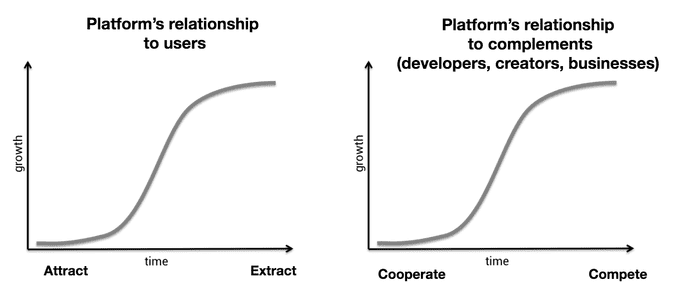
2. Which consumer needs must be met by web3 brands?
Based on NFT or ERC-20 Token, let's see what changes will happen to consumers/communities/brands
consumer:
- Demand has been upgraded from "consumption" to "consumption + assets + digital identity" trinity
- Consumers are upgraded to "sovereign individuals", and brands are not just consumer goods. It has also become the personal asset of consumers (Token holders). Consumers will put more emotion and energy into it to help brands/personal assets grow; at the same time, consumers will also have more benign creative incentives, making this investment process continue
- For Generation Z consumers (GenZ), they are more willing to establish a unique digital identity (digital identity) to show their personality and serve as a pass for the metaverse, which requires a corresponding brand to satisfy
Community:
- Compared with the web2 community, which is like a loose interest group, because web3 consumers have more practical input and rights, the condensed community consensus is deeper and more energetic, and an equal relationship with the brand will gradually form.
- Water can carry a boat and it can overturn it. A strong community can not only accelerate the growth of a brand, but also FUD (Fear, uncertainty, and doubt**,** simply means to create and spread negative news) brand. The brand itself must face up and embrace
brand
- Based on the above analysis, brands must be able to meet the new needs of new users, otherwise they will be eliminated by the times
- As the proportion of users' virtual consumption increases, traditional brick-and-mortar brands must prepare and respond in advance, have the ability to provide virtual products in the future, or combine virtual and real products, and have a place in the revenue. The fastest mover among them is Nike, which has generated more than 185 million US dollars in revenue, ranking first in the revenue list of big brand NFT projects
- Brands need to become a symbiotic relationship with consumers/communities to share benefits, rather than a unilateral consumption relationship of web2
To sum up in one sentence, users have changed, their needs have changed, and there needs to be brands and (combination of virtual and real) products that can satisfy the "sovereign individual". In essence, web3 is rebuilding the relationship between brands and consumers, and even changes the attribution of "brand sovereignty", giving consumers the right to become brand owners. The philosophy behind it is consistent with the entire crypto, just like the confirmation of user assets. Essentially true "user first".
Expand this "symbiotic relationship"
- (Gen Z) consumers need web3 brands to help build digital identities while owning brand equity and gaining more equity from brands. From the user's point of view, it is no longer simply consumed or even materialized by the brand, but becomes the owner of the brand to build and share benefits together. And in this process, the community has a strong power of consensus
- For the brand, various costs are reduced, including customer acquisition, product definition, testing and promotion costs. Grow and spread faster thanks to a community with a strong consensus
This symbiotic and win-win relationship will surely breed a very competitive web3 native brand. Then in a highly competitive market, traditional brands will be very active in web3 transformation.
So here we answer the first question
Q: Why is web3 important for brands, or is brand web3ification bound to happen?
A: Because only the web3 brand needs to meet the trinity needs of "consumption + assets + digital identity" of "sovereign individuals". The web3 brand is not only a change in marketing methods and income structure, but essentially to meet the new needs of new users, and it is a change in mindset, building or reconstructing the brand from the original user.
What: What category is suitable for a web3 brand?
What kind of categories are suitable for web3 brands? My answer is that any category that can be community-driven is worth checking out. Users participate in product definition, production, testing and promotion, and part of the profit of the product flows back to the community. In this process, users and the brand achieve a win-win situation. Tokens support user participation and benefit distribution in this process.
Because it is community-driven and can form a brand, the category needs to meet the following conditions
- low production cost
- Short test period
- High variety of categories, easy to form a brand
In theory, the categories that require a large number of test items meet the above three conditions. To be more specific, clothing, food (drinks), and dramas are all perfectly matched categories. In the example below, it can also be seen that a large number of web3 brand entrepreneurs have also chosen the above three categories.
How: How to build a web3 brand
"How to build a web3 brand" itself is a very big topic, and there is currently no so-called "best practice", and various players on the track are also exploring. This section attempts to answer this question in two parts, hoping to inspire and help readers.
- The key differences between web3 and web2 brands, and the skill tree that brands need to build at their core
- Through 4 case studies, a more figurative study on how to build a web3 brand, including different categories and building methods
The key differences between web3 and web2 brands, and the skill tree that brands need to build at their core
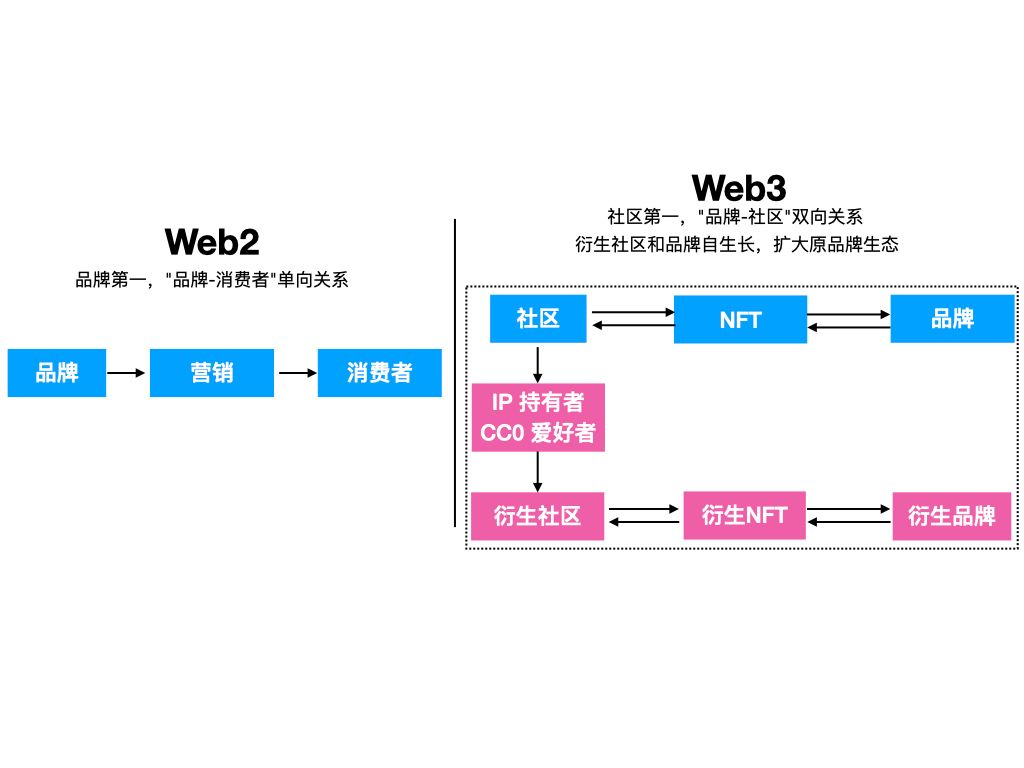
I drew a picture to more clearly describe the 2 key differences between web3 and web2 brands, and also 2 win-win strategies
Win-win strategy 1: Community first, "brand-community" two-way relationship
- Compared with web2 brand's "brand first" or "product first", and "brand-consumer" one-way relationship; web3 brand needs "community first", and "brand-community" has a two-way relationship. Why do you need community first?
- In chronological order, the community first, then the brand : As explained above, there are more than consumer goods behind the brand. It has also become the personal asset of consumers (Token holders), so consumers are also investors. Even users are investors first, and consumers second, because it takes a certain amount of time (3 months to 1 year) to build consumer goods, and start-up capital is needed before building, and a "(potential) investor community" needs to be built, So in chronological order, first the community and then the brand.
- From the perspective of affiliation, the community first and then the brand : because users have dual identities of investors/consumers at the same time, as the owner of the brand, they have the right to participate in the definition and construction of the brand. Therefore, from the perspective of affiliation, the owner (community) comes first and then the brand.
- In terms of importance, first the community and then the brand : "brand-community" constitutes a two-way relationship. The brand not only grows and spreads with the help of the community, but also community users will invest more emotion and energy in it to help the brand/personal assets grow. In this process, a strong community consensus has been formed, and the brand vision relies on this consensus. Therefore, the order of importance is "community→consensus→brand". The community is the foundation of a brand, and a brand without a community is a tree without roots and water without a source.
Win-win strategy 2: Derivative community and brand self-growth, expand original brand ecology
- This is also a very different point between the web3 brand and web2. Through the power of community users, a larger derivative community and brand ecology can be built to feed back the original brand. I marked it in pink in the above picture.
- Unlike the web2 brand, which controls the IP and makes money from it, most web3 brands have authorized the IP to the NFT holder (Holder), and the CC0 brand has opened the IP to everyone. Community users can use the IP or CC0 IP they hold to start a derivatives community based on the original brand community.
The above are the changes in the mindset of web3 brand building. Let's compare the difference in the skill tree that web2 and web3 brands need to build. It can be clearly seen that there are still those things in terms of types, but unlike web2, where all things are controlled internally by the brand, the foundation of all operations of web3 brands is the community. How to combine all work with "community operation" is the The biggest challenge in the actual work of the web3 brand side. In short, building a web3 brand is essentially building a community.
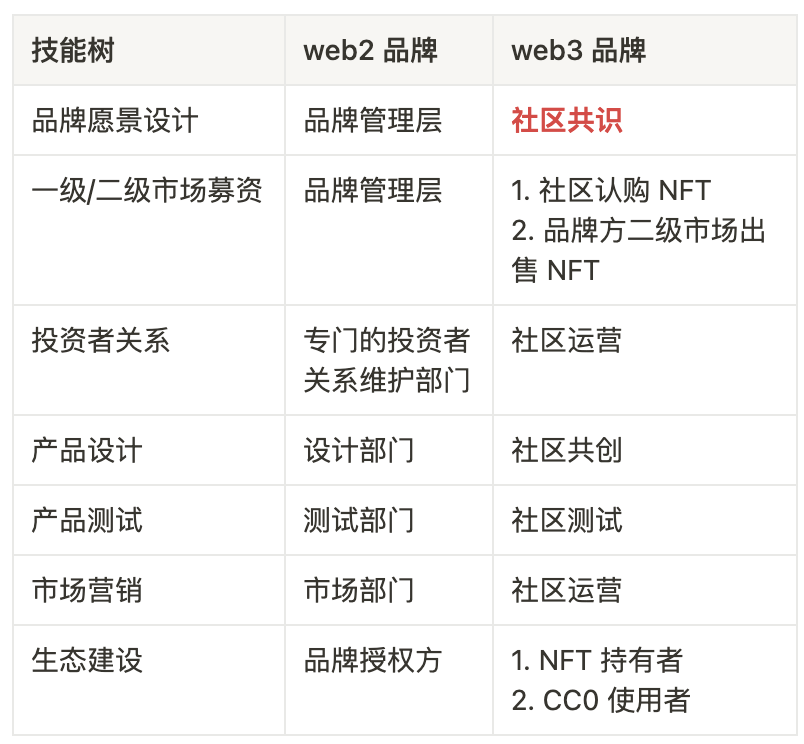
case analysis
1. Web3 Community Incubation Brand: FWB x Taika
Taika is a coffee start-up brand, and now they are launching a new sub-brand and category - yerba mate , this time they did not choose to build it entirely by themselves, but incubate with FWB (Friends with Benifits).
- FWB is recognized as the most creative DAO (Decentralized Autonomous Organization) in web3
- FWB members have a stricter joining mechanism: they need to hold a certain amount of $FWB tokens, then fill in the application form and join after review. It can be considered that the joining members have a certain degree of creativity, and jointly hold the FWB Token assets
cooperation method:
Scope of cooperation: brand investment, taste definition, testing, promotion and benefit distribution, basically covering the whole link of brand building
Brand investment: FWB invests in new yerba mate brand in the form of its own token
Taste definition, testing, promotion
- FWB members can apply to join a paid working group to work with Taika colleagues to define product concepts, design flavors and formula packaging, and produce design and marketing materials
- After the product is defined, 2 flavors are formed, the red can and the blue can. Based on a set of 500 NFTs issued by the FWB community, buyers can exchange a box of drinks and vote to decide which one will be listed after tasting. Note that this set of NFTs is not limited to being purchased by FWB members, and actually starts a spin-off community for new brands
Benefit distribution: Profits from new product sales will be shared by Taika and FWB, with FWB getting 18%
At present, the product is in the stage of voting on which one will be listed. Let's summarize the benefits of having this new brand driven by the FWB community
- Based on the test NFT issued by the FWB community, a derivative community for new brands was actually launched, which solved the cold start problem of brand headaches and ensured the quality of community members.
- Through $FWB token investment and profit sharing, FWB members effectively become owners of new brands, with greater motivation to define, design and promote, helping Taika create the best products and sell more products. Tell your friends that I participated in the design of this drink, is it a face for Beer?
In addition, a friend asked, many beverage brands (such as Yuanqi Forest) also have a large number of ab tests on flavors and packaging, and even a large number of internal employee tests. What is the difference between FWB x Taika?
- The biggest difference is that for web2 brands, brand designers and testers/consumers have a separate one-way relationship, and the latter only passively accepts the former's decision, which makes it difficult to have a strong sense of identity and initiative. Even if it is an internal employee, it is more just a task to complete (think about us helping to test the products of the next group in a large factory); but the real owners of the web3 brand are community users, and the final sense of identity and initiative is formed. Completely different, this difference determines the acceleration of brand growth.
- Repeat with me 3 times the core difference between web3 branding and web2: community, community, community :)
BTW, after establishing the cooperation model with Taika, FWB has confirmed the next cooperation with Hennessy and Reebok, and successfully expanded from a start-up company to an international first- and second-tier brand.
Thanks to Chao for sharing the above case in web101.
2. NFT holders establish derivative brands: Yuga Labs/BAYC derivative brands
Although the public's first impression of BAYC (The Boring Ape) is that stars change their avatars, in fact, it has brought an innovation that affects the entire NFT ecology - IP business authorization
- After purchasing BAYC, the corresponding number of NFT IP will be automatically authorized to Holder, including commercial use
- The representative project of NFT, CrytoPunks, has not opened IP authorization until it was acquired, which makes NFT a lot of controversy. What did users buy?
- BAYC has created a precedent for IP commercial authorization, increasing the rights and interests of IP empowerment for the holder. What users buy is not only a small picture, but also the huge IP value behind it.
Based on this, a large number of BAYC holders have developed nearly 80 derivative brands based on BAYC IP, including fashion brands, music, trendy games, food, beverages, skateboarding, basketball, clubs, podcasts, games, etc. On the one hand, BAYC IP and the community helped these derivative brands to do a cold start, and on the other hand, these derivative brands also enhanced the utility of the original IP and expanded the ecology, attracting more users to join, and finally forming a win-win situation between the original brand and the derivative products .
The article " Yuga Labs' IP Empire: Nearly 80 Brands, Creators, Projects and Artists " written by Forj CEO Harry Liu provides a comprehensive introduction to these 80 IPs. Interested friends can read them directly, and I won't repeat them here. .
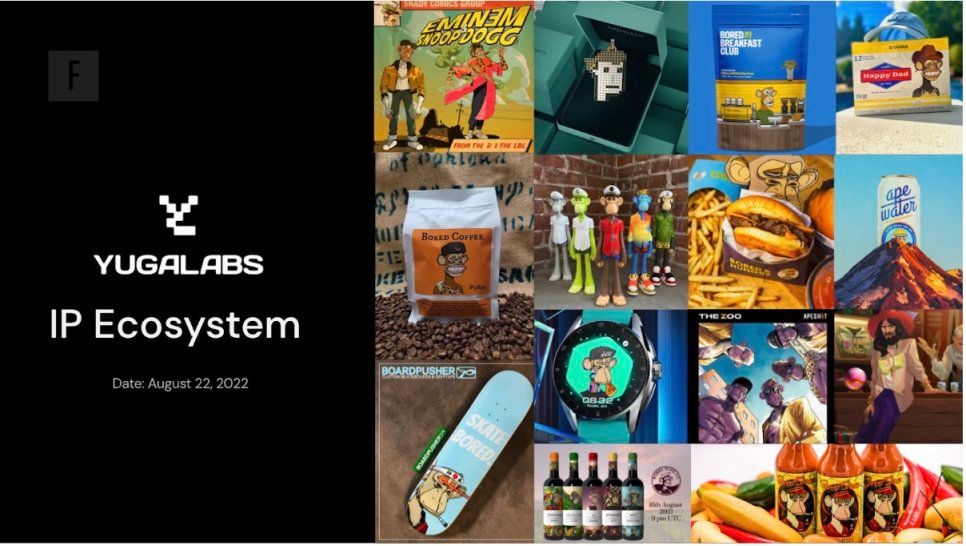
3. CC0 enthusiasts build a derivative brand: Mfers derivative brand
First quote a paragraph from a previous article about CC0 to quickly understand CC0
CC0 is short for Creative Commons Zero Copyright Agreement. By adopting this agreement, the author declares to give up all copyrights of the creation, and the creation enters the public domain and becomes the common intellectual property of mankind.
In the vernacular, everyone can use CC0 creations, including commercial and secondary creations
- The BAYC (not CC0) mentioned in the previous section opens IP Rights to the owner. Li Ning bought BAYC #4102, so Li Ning can put this monkey on posters and T-shirts (other monkeys that don't have it will not work)
- Since mfers is a CC0 protocol, no matter whether you hold mfers or not, you can freely use 10,000 mfers, including for your own use (for printing T-shirts), for commercial use (for printing T-shirts and selling), and for secondary creations…
According to incomplete statistics, there are more than 50 NFTs derived from mfers, and there are countless cafes that use mfers offline. Compared with the top brand BAYC, it is not inferior in quantity, although the price is only less than 1/50 of BAYC. How is this done and why do these spin-off brands choose to be based on mfers?
I have come up with 2 reasons
- The meme "Are you winning son?" of mfers itself is well-known in European and American cultures. Coupled with the characteristic operation of the creator Sartoshi, the IP of mfers has a certain popularity and community foundation.
- Since it is a CC0 protocol, everyone can use it at zero cost or even commercialize it. mfers has become the first choice for many brands to attract web3 users or GenZ users. For example, Meta Space in Beijing, OFFF in Shanghai, and Social Beast in Hangzhou, these three web3-themed cafes all use mfers as decorations, which further enhances the influence of the original IP.

4. Co-create an animated series: The Real Metaverse
The first few examples are all about physical consumer goods, and finally we introduce a cultural and creative category - animation series, The Real Metaverse
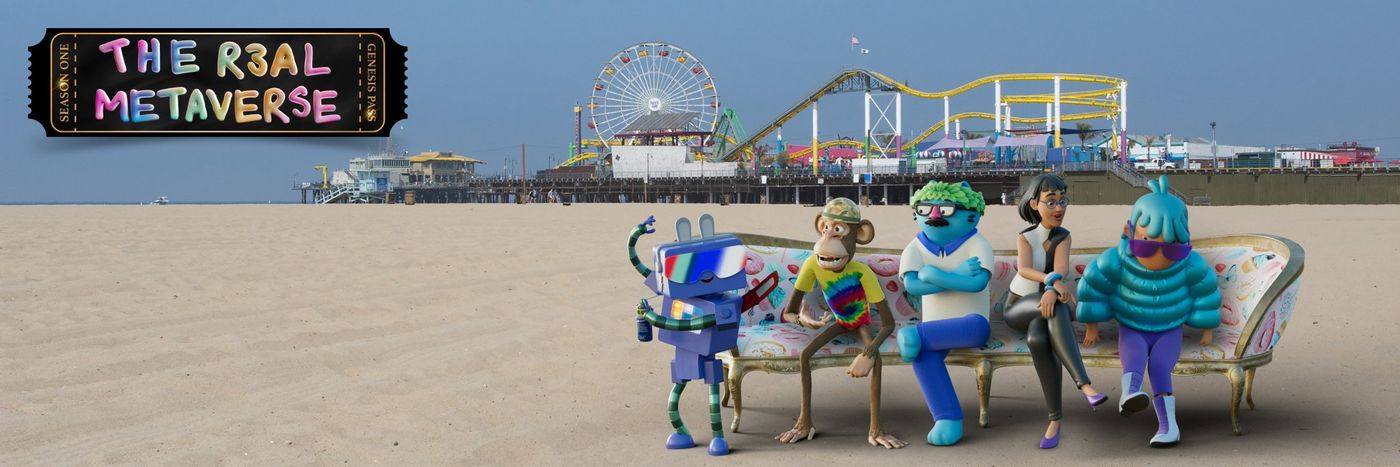
The Real Metaverse is a co-created animated series from parent company @InvisibleUniv . How to co-create it? If you hold their Producer Pass NFT
- Opportunity to contribute to the first season (34 episodes) animation, decide the character's lines and fate
- If you are the holder of 5 NFTs of BAYC, Doodles, CoolCats, Robots, World of Women, you can apply for the PFP you hold to appear in the first season animation, wow!
- If you do not hold the above 5 NFTs, you can vote for your own NFTs to appear in the second season animation
Isn't it fun? Animated series is very suitable for community co-creation. Compared with novels, the holders themselves are emotionally invested in PFP. If they can appear in the screen plot, it will greatly mobilize the enthusiasm of the holders to participate, contribute content to the series and do it. promotion. At the same time, this matter is also a win-win. Through community participation, the animation series itself has gained more attention and commercial value, which will drive the corresponding Producer Pass NFT to increase in value; at the same time, the holder's PFP will also increase in value through exposure. Imagine, your PFP becomes a movie star!
All of this is inseparable from the participation and contribution of the community. So from the beginning, The Real Metaverse cooperated with the above 5 communities to build its own community for cold start. This project is starting mint today, wait and see~
3 other important Q&As
1. What is the most important thing in the initial stage of building a web3 brand?
Bring in the right community members, and define the right OKRs and North Star metrics.
Because the community is so important to the web3 brand, and the initial community members will have a very large impact on the consensus, it is necessary to strictly screen members and set a reasonable NFT issuance price at the beginning of the community's establishment. In the current market environment, most NFT offerings are "traders" and focus on short-term benefits; however, the users that brands hope are "creators" and "consumers" who bring long-term value. But users can't ignore it when they come. This gap will make the brand's energy focus on the wrong place, but it will delay the building of the brand and the acquisition of target users, and even be kidnapped and attacked.
As a brand, you need to define the correct OKR and North Star indicators, and avoid being led by vanity indicators such as transaction volume. These are the basic skills to build a brand, product or even a company. From the indicators that the brand side is concerned about, we can also see how strong it is. For example, the most important metrics for the founders of Yuga Labs are the number of NFT holders and the number of active people in the community. He does not want NFTs to be hoarded for profit by holders, but to attract more community members, so the founding team only holds one BAYC per person.
In one sentence, do long-term valuable things, and set and manage short-term expectations.
2. My model is a member club, do I have to switch to web3? It doesn't seem like a big difference?
Converting membership card to NFT has the following benefits, including 3 user side and 1 brand side benefits
User Perspective 1: Enhanced Equity
- In traditional membership clubs, once users apply for a card, they often conflict with the interests of the club. Because the club can improve its own profits by reducing user rights and interests, and become a win-win situation
- However, as a web3 brand, users are investors, and the membership club must protect high-quality rights and interests, consistent with the interests of users; the active participation of users also enhances the brand value and forms a win-win situation
User Perspective 2: Enhancing Trading Liquidity and Value
- Traditional membership cards are difficult to trade second-hand. After becoming NFT, it will bring a natural trading market and liquidity, thereby enhancing the asset value of the membership card itself
User Perspective 3: Gaining a Personalized Identity
- Become a unique digital identity to express your personality and serve as a passport to the metaverse
- Membership cards are not necessarily static, well-designed traits can grow with users and have special effects to increase user stickiness
Brand perspective: expanding the depth and breadth of users
- Based on the data and behaviors on the chain, on the one hand, we have a more comprehensive understanding of existing users (user A holds 5 monkeys), and on the other hand, it is easier to reach incremental users (users in a certain community are especially suitable for this brand)
Therefore, the conversion of membership cards to NFTs is not only good for users, but also good for brands, why not convert them?
3. Any suggestions for traditional brands entering web3?
At the beginning, it is recommended to try light weight, understand user feedback mainly, do not send projects as soon as they come up. Li Ning bought BAYC is a good attempt, and there are a lot of CC0 projects that can be used such as mfers and black cats.
It has been analyzed at the beginning of the article that the essence of brand switching to web3 is to meet the new needs of new users and rebuild the relationship between brands and users. Don't treat the NFT project as a low-cost marketing. Once a community is established, it needs to operate continuously for a long time. Otherwise, the community may fud the brand at any time, which is not worth the loss.
In addition, the entry of traditional brands into web3 also requires the upgrade of brand mindset and organizational capabilities. Please refer to the third part of this article.
Closing & Outlook
Unconsciously, I wrote a long article from a discussion with a friend. As mentioned at the beginning, there are a large number of brands who want to enter the web3 but are unable to do so, and most of them regard sending NFT as a marketing act. But as mentioned in this article, the essence of brand switching to web3 is to meet the new needs of new users and rebuild the relationship between brands and users. There is a lot of opportunity, but it also requires an overall plan. I hope that after reading this article, the answer in my heart can be clearer.
At the same time, as a web3 surfer, I also welcome web2 brands to enter web3 and make the NFT ecosystem bigger together. On the one hand, PFP needs more narrative and utility, which is the battlefield where experienced web2 veterans can play; on the other hand, the web3ization of traditional brands is also a process of introducing new web3 users. In the news that Nike has generated more than 185 million US dollars in revenue, there is a very interesting data in Dune Analytics quoted. Among the mint users of these brand NFTs, an average of 40% is the first mint, which can be considered as NFT. new user. The promotion of 100 million NFT users requires a steady stream of web2 brands to join in to help. WAGMI!
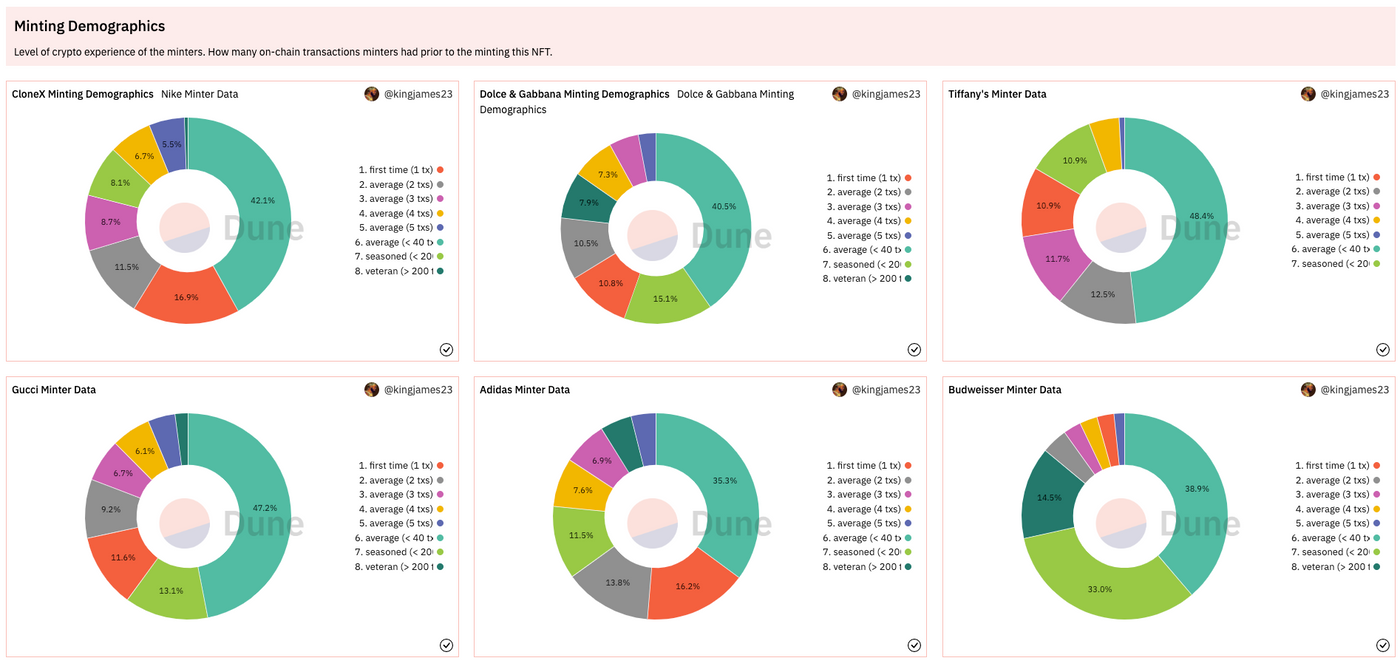
After reading this, if you think this article is helpful to you, you are welcome to click the following three tweets, like + retweet + follow, I regularly output my observations and thoughts on the NFT industry
https://twitter.com/starzqeth/status/1569834974173630464
Like my work?
Don't forget to support or like, so I know you are with me..
Comment…